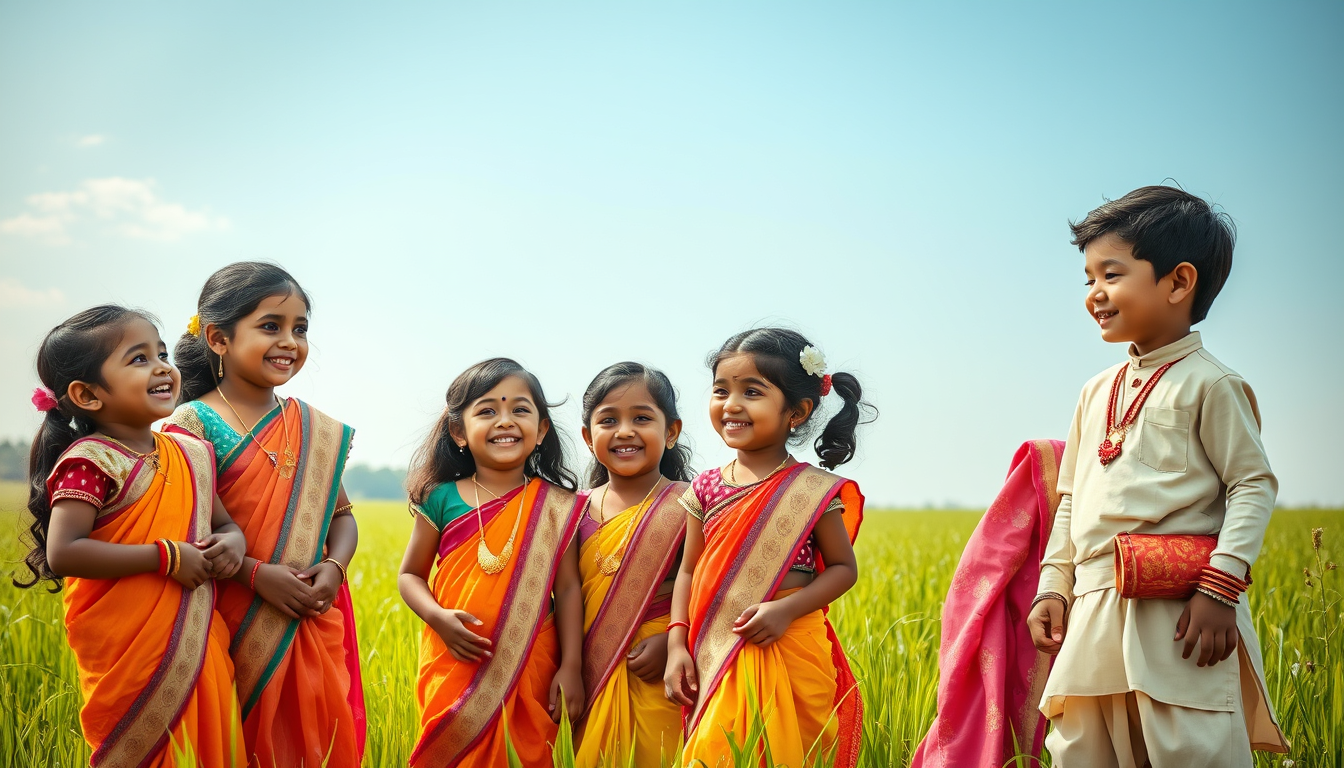Introduction
Children’s Indian clothing is a vibrant and colorful representation of India’s rich cultural heritage. From traditional attire to modern interpretations, Indian clothing for children is not just about fashion but also about preserving cultural traditions. This article delves into the world of children’s Indian clothing, exploring its history, significance, and the various styles available today.
The History of Indian Clothing
Ancient Times
The history of Indian clothing dates back to ancient times, with evidence of intricate fabrics and designs found in the Indus Valley Civilization. The ancient Indians were skilled in weaving and dyeing techniques, using natural materials like cotton, silk, and wool. The clothing was not only functional but also served as a form of self-expression and cultural identity.
Medieval Period
During the medieval period, Indian clothing evolved with the influence of various dynasties and invasions. The Mughal Empire, for instance, introduced Persian and Islamic styles, leading to the development of intricate embroidery and rich fabrics. The clothing became more elaborate and colorful, reflecting the opulence of the royal courts.
Colonial Era
The colonial era brought significant changes to Indian clothing. The British introduced Western styles, leading to a blend of Eastern and Western influences. However, traditional Indian clothing continued to be worn, particularly in rural areas and among the upper classes.
Traditional Indian Clothing for Children
Salwar Kameez
The Salwar Kameez is a traditional outfit consisting of a tunic (Kameez), a pair of loose-fitting trousers (Salwar), and a scarf (Dupatta). This ensemble is popular among both men and women and is often worn by children as well. The Kameez can be adorned with intricate embroidery, mirrors, and beads, making it a beautiful piece of clothing.
Lehenga Choli
The Lehenga Choli is a traditional outfit consisting of a long skirt (Lehenga), a blouse (Choli), and a dupatta. This outfit is typically worn by women and girls during festivals and special occasions. The Lehenga is often adorned with intricate embroidery and mirrors, while the Choli is usually made of a lighter fabric.
Sherwani
The Sherwani is a traditional outfit consisting of a long coat-like garment worn over a kurta and salwar. This outfit is popular among men and boys and is often worn during formal occasions. The Sherwani can be made of various fabrics and is often adorned with intricate embroidery and gold or silver threads.
Modern Interpretations of Indian Clothing
Fusion Styles
In recent years, there has been a trend towards fusion styles, where traditional Indian clothing is combined with modern Western styles. This has led to the creation of unique and stylish outfits that blend the best of both worlds. For example, a traditional Salwar Kameez can be paired with modern sneakers or a Western-style jacket.
Casual Wear
Indian clothing has also evolved to include casual wear options for children. This includes t-shirts, jeans, and shorts with traditional Indian prints and designs. These outfits are perfect for everyday wear and allow children to express their cultural identity in a modern way.
The Significance of Children’s Indian Clothing
Cultural Preservation
Children’s Indian clothing plays a crucial role in preserving India’s cultural heritage. By wearing traditional clothing, children are exposed to the rich history and traditions of their country. This helps to foster a sense of pride and identity, ensuring that these cultural practices are passed down to future generations.
Self-Expression
Indian clothing for children also provides an opportunity for self-expression. The vibrant colors, intricate designs, and unique fabrics allow children to express their individuality and creativity. This can boost their confidence and self-esteem, helping them to develop a strong sense of self.
Educational Value
Wearing traditional Indian clothing can also have an educational value. It provides an opportunity to learn about the history, culture, and traditions of India. This can be a great way to teach children about their heritage and the importance of preserving cultural practices.
How to Choose the Right Indian Clothing for Children
Age Appropriate
When choosing Indian clothing for children, it is important to consider their age. Younger children may prefer more comfortable and casual styles, while older children may want to explore more traditional and formal outfits.
Comfort and Fit
Comfort and fit are also important factors to consider when choosing Indian clothing for children. The clothing should be made of breathable fabrics and should fit well to ensure that the child is comfortable throughout the day.
Occasion
The occasion for which the clothing is being worn should also be taken into account. For example, traditional Indian clothing may be more appropriate for festivals and special occasions, while casual wear may be more suitable for everyday use.
Quality and Durability
The quality and durability of the clothing are also important factors to consider. The clothing should be made of high-quality materials that are durable and long-lasting. This will ensure that the clothing can be worn for many years to come.
Popular Brands for Children’s Indian Clothing
FabIndia
FabIndia is a popular brand that offers a wide range of Indian clothing for children. They specialize in traditional and modern styles, with a focus on high-quality materials and unique designs.
Anokhi
Anokhi is another popular brand that offers a range of Indian clothing for children. They specialize in handcrafted and handloom products, with a focus on traditional techniques and designs.
Biba
Biba is a well-known brand that offers a range of Indian clothing for children. They specialize in modern and fusion styles, with a focus on vibrant colors and unique designs.
Conclusion
Children’s Indian clothing is a vibrant and colorful representation of India’s rich cultural heritage. From traditional attire to modern interpretations, Indian clothing for children is not just about fashion but also about preserving cultural traditions. By wearing traditional Indian clothing, children can express their cultural identity, boost their confidence, and learn about their heritage. Whether you are looking for traditional or modern styles, there are many options available to choose from. So, why not explore the world of children’s Indian clothing and help your child embrace their cultural heritage?
